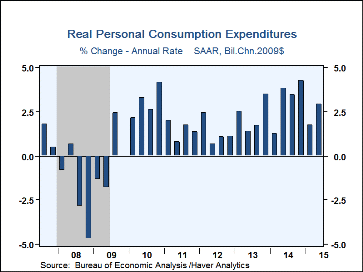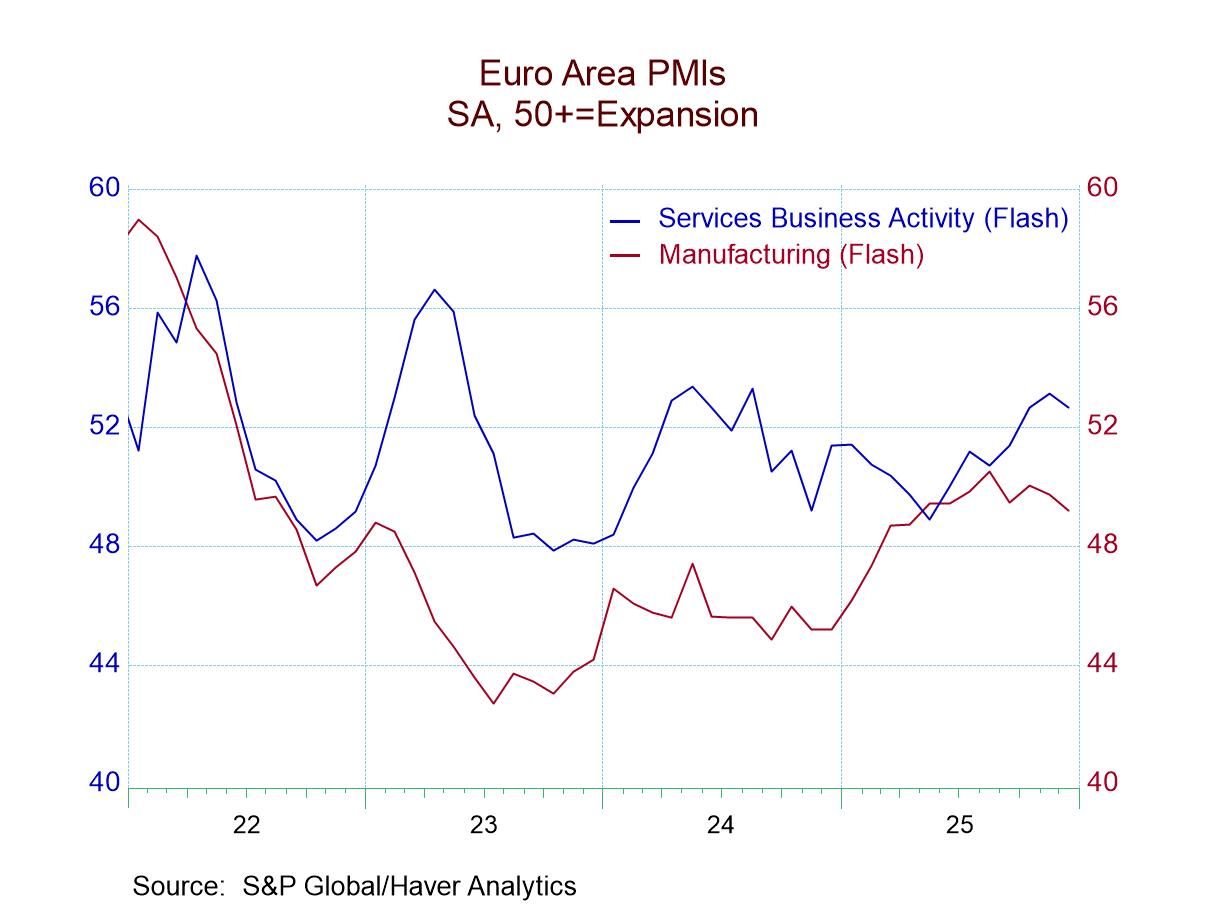 Global| Jul 30 2015
Global| Jul 30 2015U.S. GDP Growth Improves; Consumer Leads the Advance
by:Tom Moeller
|in:Economy in Brief
Summary
The Commerce Department estimated that overall economic growth accelerated to 2.3% last quarter (SAAR) versus a 0.6% Q1 increase, revised from -0.2%. It was the quickest rate of growth since Q3 2014 but it missed expectations for a [...]
The Commerce Department estimated that overall economic growth accelerated to 2.3% last quarter (SAAR) versus a 0.6% Q1 increase, revised from -0.2%. It was the quickest rate of growth since Q3 2014 but it missed expectations for a 2.7% rise in the Action Economics Forecast Survey. Economic growth during 2014 was unrevised at 2.4% but growth in 2013 was reduced to 1.5% from 2.2%. Growth in 2012 remained unchanged at 2.3%.
Consumer spending growth improved to 2.9% following deceleration to 1.7% in Q1. Growth in spending on motor vehicles rebounded to 10.5% (4.6% y/y) following a 3.5% decline. Furniture & appliance spending eased to 3.1% (5.1% y/y), the weakest advance since Q1'14. Clothing spending growth recovered to 5.5% (3.6% y/y) following a Q1 decline. Services consumption grew at a 2.1% rate (2.9% y/y), helped by a 6.7% surge (4.9% y/y) in spending at restaurants & hotels.
Capital investment backpedaled at a 0.6% rate, the first decline since Q3'12. The shortfall was paced by a 4.1% drop (+2.1% y/y) in equipment spending, mostly due to a 13.7% decline (-2.1% y/y) in information processing equipment investment. Structures spending eased at a 1.6% rate (-1.7% y/y) but investment in intellectual property products surged 5.5% (6.6% y/y).
Residential investment grew 6.6% (7.5% y/y), the most moderate growth of the last three quarters.
Government consumption & investment improved at a 0.8% rate bolstered by a 2.0% rise (0.8% y/y) in state & local spending. Federal defense expenditures declined at a 1.5% rate (-1.7% y/y) and nondefense spending eased at a 0.6% rate (+1.3% y/y).
Inventory decumulation sapped 0.1 percentage points from GDP growth last quarter. Trade deficit improvement added that amount back as exports rose at a 5.3% rate (1.5% y/y) following a 6.0% decline. Imports grew at a 3.5% annual rate (4.9% y/y), the weakest gain in nine months.
The GDP chain price index advanced at a 2.0% rate (1.0% y/y) following negligible upticks during the prior two quarters. The personal consumption price index advanced 2.2% after two quarters of decline, but the index excluding food & energy gained 1.8% following two quarters of 1.0% rise. The private capital investment price index eased at a 1.1% rate (+0.1% y/y) and the residential investment price index fell 1.5% (+2.4% y/y), the second straight quarter of modest decline.
The latest GDP figures can be found in Haver's USECON and USNA databases; USNA contains virtually all of the Bureau of Economic Analysis' detail in the national accounts, including the integrated economic accounts and the recently added GDP data for U.S. Territories. The Action Economics consensus estimates can be found in AS1REPNA.
| Chained 2009 $, %, AR | Q2'15 (Initial Estimate) | Q1'15 | Q4'14 | Q2 Y/Y | 2014 | 2013 | 2012 |
|---|---|---|---|---|---|---|---|
| Gross Domestic Product | 2.3 | 0.6 | 2.1 | 2.3 | 2.4 | 1.5 | 2.3 |
| Inventory Effect | -0.1 | 0.9 | -0.0 | 0.1 | 0.0 | 0.1 | 0.2 |
| Final Sales | 2.4 | -0.2 | 2.1 | 2.2 | 2.4 | 1.4 | 2.1 |
| Foreign Trade Effect | 0.1 | -1.9 | -0.9 | -0.5 | -0.1 | 0.2 | 0.2 |
| Domestic Final Sales | 2.2 | 1.7 | 3.0 | 2.7 | 2.5 | 1.2 | 1.9 |
| Demand Components | |||||||
| Personal Consumption Expenditures | 2.9 | 1.7 | 4.3 | 3.1 | 2.7 | 1.7 | 1.5 |
| Business Fixed Investment | -0.6 | 1.6 | 0.7 | 2.6 | 6.2 | 3.0 | 9.0 |
| Residential Investment | 6.6 | 10.1 | 9.9 | 7.5 | 1.8 | 9.5 | 13.5 |
| Government Spending | 0.8 | -0.1 | -1.4 | 0.3 | -0.6 | -2.9 | -1.9 |
| Chain-Type Price Index | |||||||
| GDP | 2.0 | 0.1 | 0.1 | 1.0 | 1.6 | 1.6 | 1.8 |
| Personal Consumption Expenditures | 2.2 | -1.9 | -0.4 | 0.2 | 1.4 | 1.4 | 1.8 |
| Less Food/Energy | 1.8 | 1.0 | 1.0 | 1.3 | 1.5 | 1.5 | 1.9 |
Tom Moeller
AuthorMore in Author Profile »Prior to joining Haver Analytics in 2000, Mr. Moeller worked as the Economist at Chancellor Capital Management from 1985 to 1999. There, he developed comprehensive economic forecasts and interpreted economic data for equity and fixed income portfolio managers. Also at Chancellor, Mr. Moeller worked as an equity analyst and was responsible for researching and rating companies in the economically sensitive automobile and housing industries for investment in Chancellor’s equity portfolio. Prior to joining Chancellor, Mr. Moeller was an Economist at Citibank from 1979 to 1984. He also analyzed pricing behavior in the metals industry for the Council on Wage and Price Stability in Washington, D.C. In 1999, Mr. Moeller received the award for most accurate forecast from the Forecasters' Club of New York. From 1990 to 1992 he was President of the New York Association for Business Economists. Mr. Moeller earned an M.B.A. in Finance from Fordham University, where he graduated in 1987. He holds a Bachelor of Arts in Economics from George Washington University.












